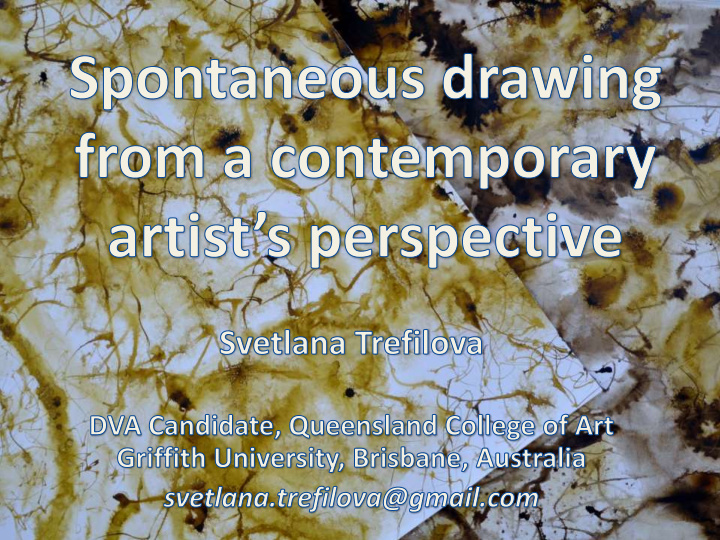



Content • Introduction • Spontaneous drawing and post modern theory • Artist’s practice • Comparison with contemporary practitioners • Conclusion
Raised questions • Is spontaneous drawing a conscious or a subconscious process? • Why do people use different marks, lines and symbols? • Why is this technique so widely used and attractive for many artists?
Brice Marden, Post Calligraphic Drawing , 1998, Private Collection, New York. Source: Studio International, viewed 20 September 2015, <http://www.studiointernational.com /index.php/brice-marden-a- retrospective-of-paintings-and- drawings>
Svetlana Trefilova, Chlorophilia (Microcosm series), ink on paper, 55 x 45 cm, 2015
Svetlana Trefilova, Watery Painting Technique, video 1, 2015
Svetlana Trefilova, fragment , acrylic on canvas, 2015
Svetlana Trefilova, fragment , acrylic on canvas, 2015
Andre Masson, Automatic Drawing , 1924 Source: The Surrealist Perspective, viewed 15 September 2015, <https://surrealismfall2012.wordpres s.com/2012/11/16/andre-masson- and-the-automatic-drawing/>
Terry Winters, Internal and External Values , print, 1998 Source: The Metropolitan Museum if Art, viewed 15 September 2015 http://www.metmuseum.org/collection/the-collection-online/search/491835
Su Sheedy, Summit , encaustic art, 2011 Source: Su Sheedy, viewed 17 September 2015 <http://susheedy.blogspot.com.au/2011/01/summit.html>
A fresh rhizome of Cimicifuga racemosa A fresh rhizome of Cimicifuga racemosa Source: Schizophrenic Summer, a fly-trap for fleeting thoughts on Deleuze and Guattari …, viewed 15 September 2015, < https://schizophrenicsummer.wordpress.com/2008/07/17/unity-through-rhizome/>
Svetlana Trefilova, Rhizome (Moreton Island, April 2015), photo
‘A rhizome has no beginning or end; it is always in the middle, between things, interbeing, intermezzo. The tree is filiation, but the rhizome is alliance, uniquely alliance .’ (Deleuze and Guattari 2004, 25). Source: The Web as Rhizome in Deleuze and Guattari, viewed 17 September 2015 <http://bluelabyrinths.com/2015/07/15/the-web-as-rhizome-in-deleuze-and-guattari/>
Deleuze and Guattari defined six principles of rhizome (Deleuze and Guattari 2004, 7-14) • the principles of connection and heterogeneity – any point could connect with anything else without privilege of hierarchy rather than mixing in homogeneous substance; • the principle of multiplicity – everything is connected to anything in woven manner and creates assemblage of multiplicities; • the principle of asignifying rupture – if part of a rhizome is broken, it will start up again on its old or new lines of flight, deterritorializing or reterritorializing the growth; • the principles of cartography and decalcomania – rhizome is a creative map which is always unfinished, could be continued to any direction and does not have a privilege point of entry or exit, however this map could consist of pre-set elements traced from some archetypes, similar to how plants and their elements can be considered copies of their ancestors.
Svetlana Trefilova, Zygote, ink on paper, 33 x 43 cm, 2015
Svetlana Trefilova, Precious 1 (Microcosm series), ink on paper, 33 x 43 cm, 2015 Body Without Organs (BWO) ‘The full body without organs is a body populated by multiplicity.’ ( Deleuze and Guattari 2004, 30).
Svetlana Trefilova, fragment , acrylic on canvas, 2015
Svetlana Trefilova, Thistle, ink on paper, 35 x 45 cm, 2015
Svetlana Trefilova, Watery Painting Technique, video 2, 2015
Svetlana Trefilova, Proterozoic, acrylic on linen, 76 x 102 cm, 2015
Terry Winters , Double Gravity, oil on linene, 203 x 264 cm, 1984 Source: Blue Banksia, viewed 15 September 2015, <http://www.bluebanksia.com/artist-of-the-month.html>
Terry Winters, Tessellation Figures (2) , 2011, oil on linen, 203 x 193 cm. Source: Matthew Marks Gallery, viewed 25 June 2015 http://www.matthewmarks.com/new-york/artists/terry- winters/selected-works/#/images/14/.
Donne Bitner, To Remember , 2006, mixed media on paper, 66 x 66 cm. Source: Aimone, Steven. 2009. A Practical Guide to Freeing the Artist within Expressive Drawing New York/London: Lark Books. p. 25.
Brice Marden, Study for the Muses, oil on linen, 210.8x 342.9 cm, 1997 Source: MOMA, Brice Marden, viewed 15 September, 2015, <http://www.moma.org/visit/calendar/exhibitions/2>
Recommend
More recommend